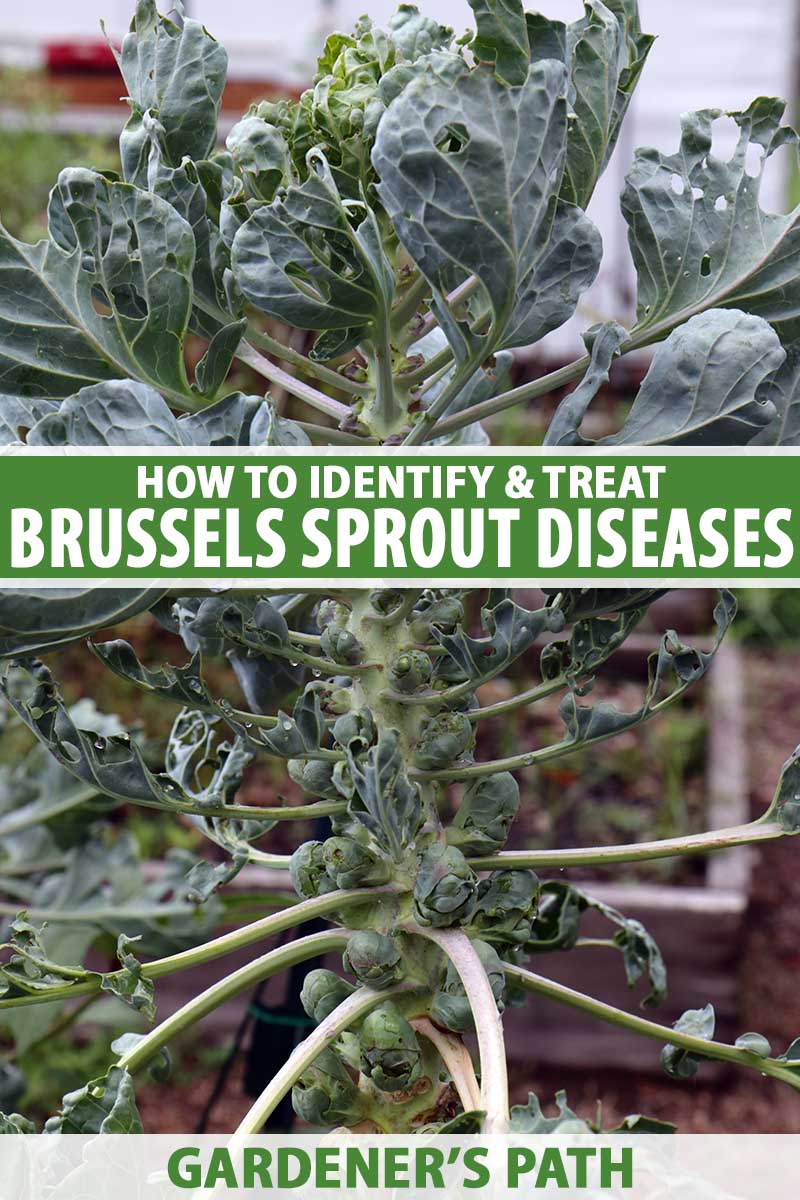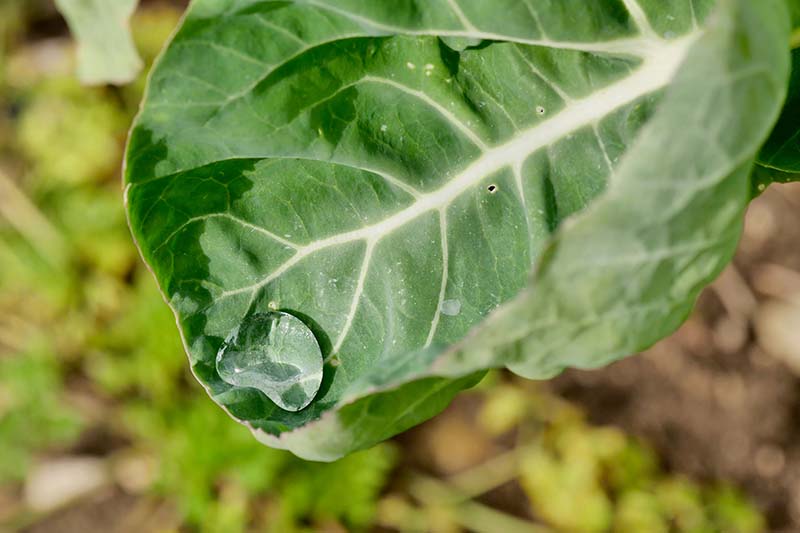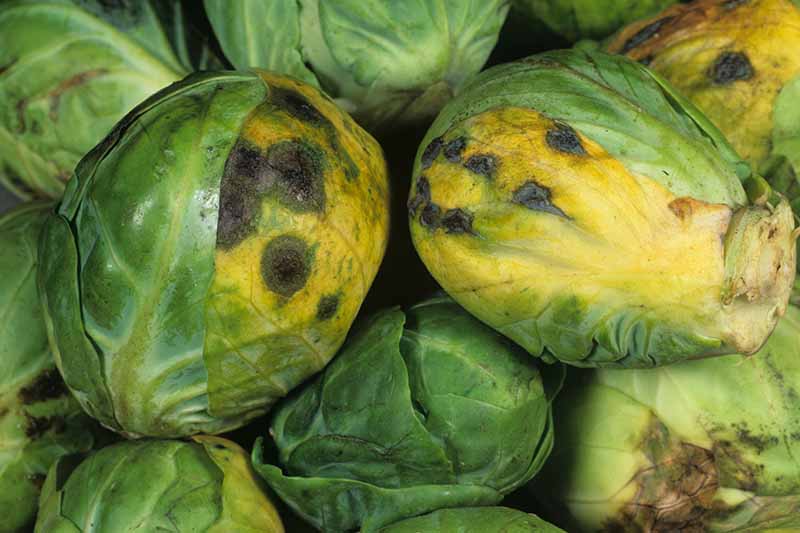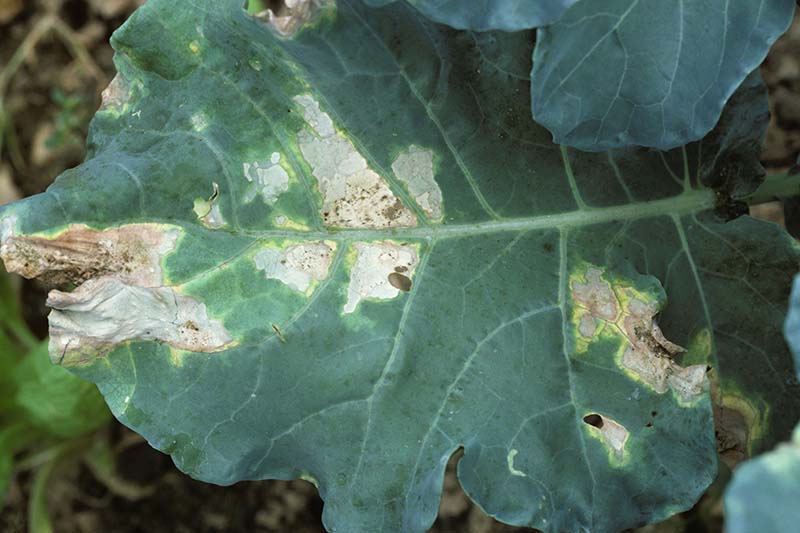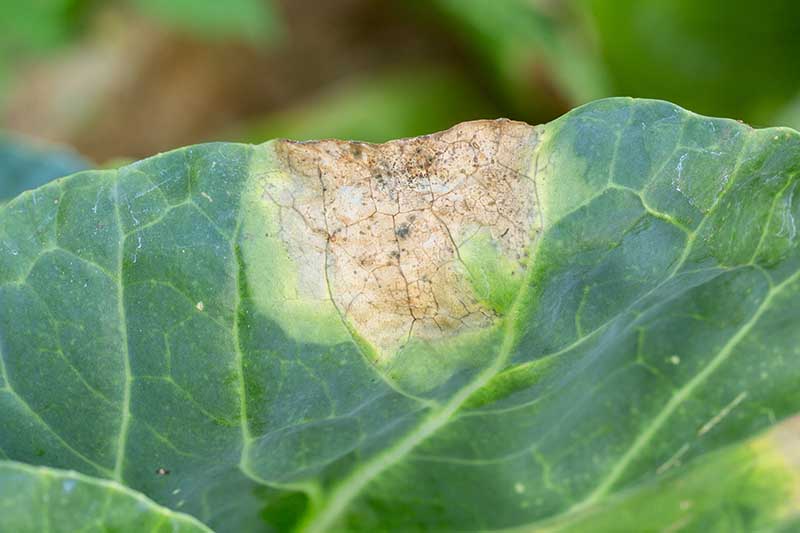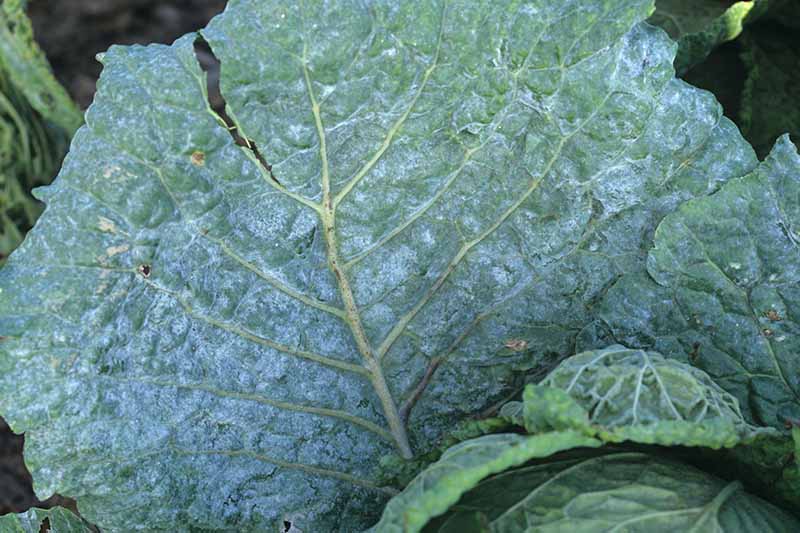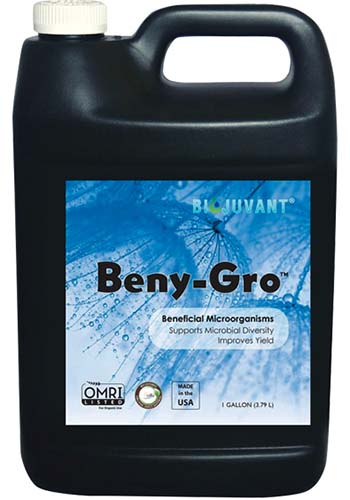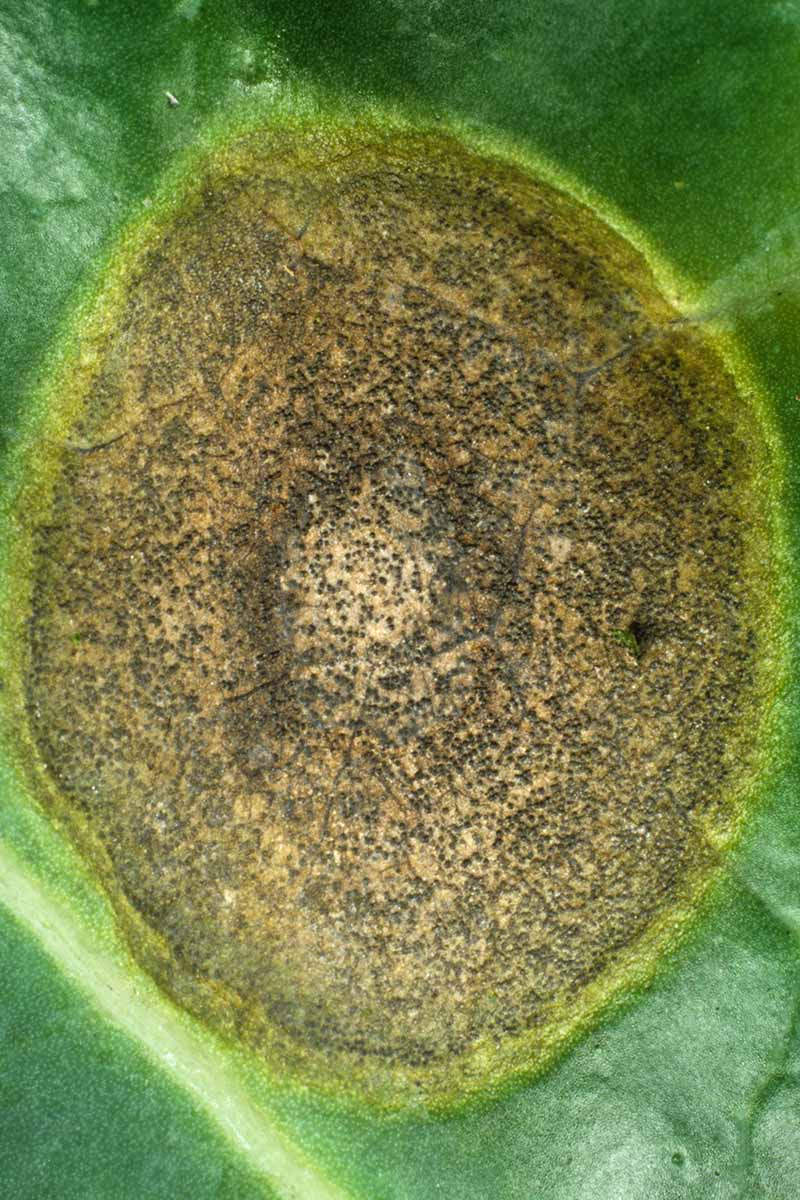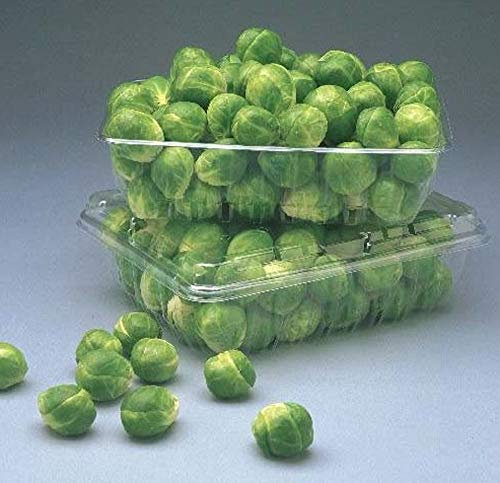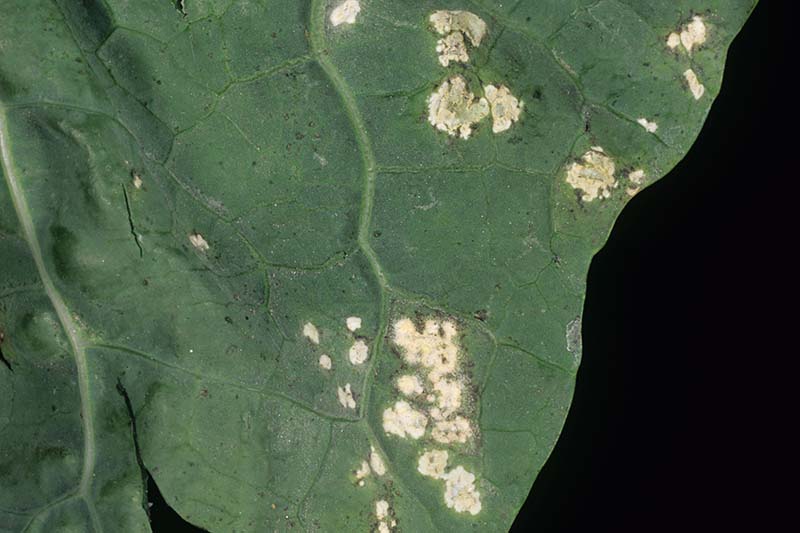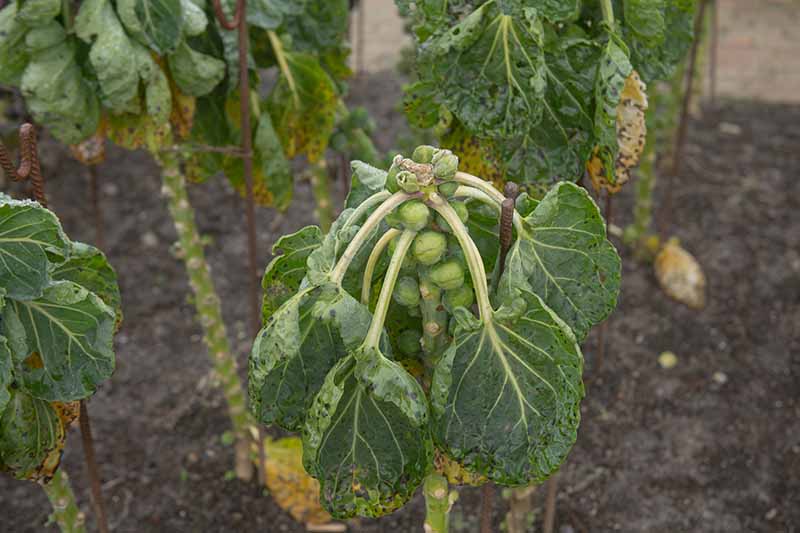But there’s something extra special about early spring and fall veggies like brussels sprouts. You know what I’m talking about if you’ve ever set a table with a stalk of sprouts as the centerpiece. And is there anything in the world more satisfying than snapping off a ripe sprout straight from the stalk in the garden? Cool-season veggies are precious because they pop up when the rest of the garden is still waking up or tucking in for the dormant season. We link to vendors to help you find relevant products. If you buy from one of our links, we may earn a commission. That’s why it’s so heartbreaking when a disease steals them before you have the chance to shave them into a salad or roast them with butter in the oven. Here’s what we’ll cover:
Best Practices to Avoid Diseases
You’re going to notice a pattern here. Many of these problems may be avoided with some good basic garden hygiene. If there’s one thing you can do that will really help you to avoid most of these problems, it’s rotating your crops. A good rule of thumb is to plant something different in the spot where your brussels sprouts were growing for the following two years. Make sure whatever you plant isn’t in the Brassica genus, since these plants can also act as hosts. It’s also a good practice to keep your garden weed-free. There are several types of weeds out there such as wild mustard that are members of the Brassica genus. These can act as hosts to many of the types of fungi and bacteria that infect brussels sprouts. Finally, always try to water at the soil level rather than on the foliage or heads of plants. Watering in the morning is best because the moisture will usually have time to dry off during the day.
11 Common Diseases in Brussels Sprouts
All brassica crops are hit hard by fungal pathogens in particular. We’ve rounded up the most common diseases you might encounter so you’ll be prepared to deal with problems before it’s too late.
1. Alternaria Leaf Spot
Black spot, also known as Alternaria leaf spot, is caused in brussels sprouts by the fungi Alternaria brassicicola and A. brassicae. At first, this disease shows up on the foliage as lots of little black spots about the size of a pinprick, but the spots rapidly expand and merge, causing the leaf to become necrotic and drop. The symptoms usually start on the lower, older leaves, but they can cover the entire plant, including the heads of the sprouts, as the problem progresses. Fortunately, it’s mostly just a cosmetic issue. And even if it does attack the sprouts, you can usually peel off the outer leaves after harvest and the inner parts will be fine. Fungicides can help if you want to keep black spot under control. Our guide to Alternaria in turnips is aimed at addressing the problem in turnip plants specifically, but you can use all the same treatments on brussels sprouts as well.
2. Bacterial Leaf Spot
Brussels sprouts do best when the weather is cool and moist. Unfortunately, so does Pseudomonas syringae pv. maculicola, the bacterium that causes bacterial leaf spot. ‘Mighty’ Having a hard time finding this particular plant? Burpee carries the seeds so you can enjoy this tasty hybrid. True to its name, it causes black or purple spots on the leaves, usually with a yellow halo. These can merge and cause the leaves to be covered in large, dry, brown patches. The pathogen lives in plant debris and seeds, and any brassica can act as a host, though cabbage, brussels sprouts, radishes, and turnips are the most common targets. If you’re gardening somewhere that stays relatively dry, you’ll probably never encounter this problem, but people in wet climates should take precautions. That means always taking care to water in the morning at the soil level, and not on the foliage or forming heads. Always purchase certified disease-free seed, and be sure to clean up any debris around your plants. You should also remove any weeds, particularly those in the Brassica genus such as mustard, cress, and pepperweed. Finally, rotate those crops. Don’t plant any brassicas in the same place more than once every three years.
3. Bacterial Soft Rot
You’ve probably come across bacterial soft rot before and you might not even realize it. This disease causes veggies and fruits of all kinds to rot in storage or out in the field. If you’ve had a potato rot into a mushy mess in storage, you might have been dealing with bacterial soft rot. It’s caused by Pectobacterium carotovorum (previously classified as Erwinia carotovora), Dickeya dadantii (previously Erwinia chrysanthemi), and certain types of bacteria in the Pseudomonas genus. These pathogens enter your sprouts through wounds on the plant. These wounds can be caused by pruning, wind damage, or insects. Insects such as aphids, leaf miners, and thrips can also carry the pathogen, and it can be spread in water or carried on tools, your hands, or even your clothes. Since there is no cure, you need to take preventative measures against this disease. Our guide to soft rot has all the tips you’ll need.
4. Black Rot
You don’t want your plants to contract any of the diseases on this list, black rot especially. It can kill an entire plant pretty rapidly. Even worse, there’s no cure. You might be able to slow it down, but once your plants have it, they have it for life. The bacteria Xanthomonas campestris pv. campestris is to blame for this devastating problem, which causes the roots to rot and the plant to die. Besides the most obvious symptom of plant death, what do you look for? At first, your brussels sprouts won’t show any symptoms. But eventually, you’ll start to see yellow splotches on the margins of the foliage. These expand into large, yellow, v-shaped patches with the pointy bit aiming towards the center of the leaf. As the disease progresses, these patches turn dry and brown with necrotic streaks. Next, the stem starts to rot from the inside and the roots rot underground. Eventually, the plant can’t support itself and it starts to wilt, even if there is plenty of moisture in the soil. It’s hard to catch this disease when it’s just beginning because you can‘t see evidence of it, and early symptoms can resemble so many other things. Water at the soil level to avoid splashing water around, since black rot pathogens spread in water. Copper fungicide is indispensable. It may be used to address all kinds of problems on this list. If you don’t already have some, Arbico Organics carries Bonide Copper Fungicide in ready-to-spray 16- or 32-ounce bottles, and a 16-ounce concentrate. Bonide Copper Fungicide Your best bet is to avoid black rot in the first place. Start by buying disease-free seed, and don’t plant somewhere where you’ve had brassicas growing in the past three years. Read more about controlling black rot in cruciferous vegetables.
5. Clubroot
With a name like clubroot, you might be picturing a plant with a big, club-like root structure underground. That’s pretty much the gist of it. Plants infected with this disease have distorted, enlarged roots with a club-like shape. Secondary roots might have big bulb-like growths. As the disease progresses, the roots start to rot. Unless you dig up your plants and give the roots a lookover, how do you know your plant is infected? It can be a bit hard to tell. Your brussels sprout plants might be stunted and they could turn yellow. The foliage will also droop and wilt easily with just a bit of heat or lack of water. There isn’t any good treatment other than adding lime to the soil to raise the pH above 7.0. This slows or stops the progression of the disease, but it doesn’t eliminate it. Since eradicating it entirely isn’t possible, how do you avoid clubroot, which is caused by an obligate biotroph protist called Plasmodiophora brassicae? Well, first, what does that mean? Let’s quickly define these terms. Rather than being a type of fungi or an oomycete, this type of disease pathogen is a single-celled eukaryotic organism that does not fit into the category of plant, animal, or fungus. Though often classified with other fungal diseases, clubroot is in fact something different. A pathogen that relies on plant cells for food without killing them (i.e. an obligate biotroph), it will nonetheless damage and cause stress to infected plants. Good garden practices like crop rotation, purchasing disease-free plants (note that it doesn’t spread via seed), watering at the base of plants, and cleaning your tools, hands, and shoes if you’ve been in a garden where the disease is present are critical for avoiding the spread of this disease. Crop rotation is always a good garden practice, but it takes on a whole new level of importance with clubroot. The pathogen can live in the soil for up to 20 years, but it doesn’t have the ability to build up as much if you only grow brassicas in the same place once every four years or so. That said, if you find that you have a serious infection that heavily impacts every plant you put there, don’t put brassicas in that spot at all anymore.
6. Damping Off
Damping off may impact a distressing number of vegetables, and an infection stops your veggie growing endeavors in their tracks. When you put your seeds in the soil, they might not emerge or, if they do, they’re weak and wilted. You might see a brown, water-soaked lesion at the base of seedling stems. If your poor seedlings survive, they’ll never thrive and you won’t have many – or more likely any – heads. To learn how to prevent and deal with damping off, check out our comprehensive guide.
7. Downy Mildew
Downy mildew is a disease caused by the oomycete Hyaloperonospora parasitica, and it’s incredibly common on brassicas and many other veggies. It also doesn’t matter whether your plant is young or old, this pathogen doesn’t discriminate, though younger plants tend to be more negatively impacted. On brussels sprouts, symptoms first appear as small yellow or brown spots on the lower leaves. These expand and can eventually kill off entire leaves. You may also see a white fungus covering the undersides of the leaves. As things become worse, the pathogen creeps into the stem, heads, and roots, and causes them to rot. It can be hard to dodge this particular problem, since it lives on seeds, in the soil, and on plant material. It can be spread on the wind and in water. Reliant (or similar products like Agri-Fos or Monterey Garden Phos) contain mono- and di-potassium salts of phosphorus acid, which help to improve the plant’s resistance to pathogens. Reliant This product is particularly effective at treating this disease, but it should be reserved for severe infections. Use it every other week while symptoms are present, but be careful not to spray anywhere where the product might runoff into any lakes, rivers, or streams. Regardless of which treatment option you choose, be sure to cover every part of the stem and leaves.
8. Powdery Mildew
Most types of fungi that infect brussels sprouts attack during cool or wet weather. But powdery mildew, caused by the fungus Erysiphe cruciferarum, likes it when it’s warm and dry. If you grow your sprouts during the early spring or late fall, you generally won’t have to worry about this disease too much. Even if your plant is infected with this fungus, it isn’t likely to have the right conditions at these times of year to really spread. But the climate is changing. Spring and fall are both becoming warmer, and the chances that you’ll come across this disease outside of the summer months are increasing. If your plants do happen to be hit with powdery mildew, here’s what you’ll see: leaves will have small, white spots that gradually turn into a powdery mold. Older leaves are usually impacted first, and new leaves aren’t hit until the disease starts to really progress. At that point, the leaves might turn yellow or brown and die off. Black spots may also form on the sprouts themselves. If powdery mildew is a common issue in your garden, treat your plants preventatively with a product that contains Bacillus subtilis. By the way, if you’re new to growing brussels sprouts, ‘Dimitri’ is an excellent hybrid for beginners. ‘Dimitri’ It’s generally disease resistant, doesn’t require topping (the process of cutting the top off sprout plants to encourage head development), and it reliably forms heads, even when environmental conditions aren’t ideal. You can grab a pack of 25 ‘Dimitri’ seeds at Burpee. You should also try to avoid letting your plants become too thirsty or giving them too much nitrogen, which can exacerbate the problem.
9. Ring Spot
Heads up, we’ve got another fungus here that’s just waiting to make a meal out of your brussels sprouts! Biojuvant Beny-Gro Biojuvant’s Beny-Gro comes in quart- or gallon-sized concentrates that you can use as a foliar spray or soil soak. Find it at Arbico Organics if you need to purchase some. To treat existing powdery mildew symptoms, break out the ol’ reliable copper fungicides. Learn more about how to treat powdery mildew in our guide. Mycosphaerella brassicicola causes a disease called ring spot which, as its name suggests, causes small spots on foliage. These spots are different from those caused by Alternaria leaf spot in that they’re gray and have tiny little flecks of black inside the circles. While the spots don’t form on the sprouts, enough spots on the leaves can slow plant growth or even reduce your harvest. It spreads in cool, moist weather via water and wind, and can live in the soil for years. Rotate your crops every year, water at the soil level, and treat with weekly sprays of copper fungicide as long as it is present.
10. Verticillium Wilt
Verticillium is terrible, horrible, no good, very bad news. It’s caused by the fungi Verticillium dahliae and V. albo-atrum and attacks tons of different veggies, from watermelon to potatoes, and all of the cole crops. There is no cure, and plants that contract this disease will often die. Vert, as it is sometimes called, usually causes less severe symptoms on brussels sprouts than it may on other types of plants. But less severe, in this case, means potentially no harvest or a severely reduced one rather than rapid death. So what symptoms are we talking about? Because much of the damage happens to roots and stems where you can’t see it, you may start to notice wilting before you see anything else. Your plants will wilt in the heat of the afternoon, even if they have plenty of water, and then recover at night or in the morning. You’ll also see brown or yellow lesions on the foliage as the disease progresses. Eventually, the leaves may die and fall off, starting with the older leaves at the bottom. Since there’s no cure, what can you do? First, plant resistant varieties such as ‘Capitola,’ ‘Confidant,’ ‘Dimitri F1,’ ‘Doric F1,’ ‘Marte F1,’ Nautic,’ and ‘Speedia.’ Rotate your crops so non-host plants grow for four years between host plants.
11. White Rust
The oomycete Albugo candida causes a disease commonly called white rust or white blister in brassicas. ‘Capitola’ Remove weeds, always sanitize your tools, and solarize your soil in the off-season to reduce the number of pathogenic fungi in the soil. The most obvious sign that your plant is infected with this pathogen is waxy raised white bumps on the underside of the foliage. These eventually turn brown. The tops of the leaves will usually have yellow spots, and the sprout heads might be small or deformed. Prevention, as always, is a better option than trying to treat the problem after it takes hold. That means rotating crops so that brassicas aren’t grown in the same place more than once every four years. Keep weeds out of your garden, and water at the base of plants. For more information on identifying, preventing, and treating white rust, check out our guide to treating white rust on turnips. The treatment and prevention process is the same for brussels sprouts. We’d love it if you’d come back and share your battle stories with us in the comments. It might even help someone else to deal with their own disease challenge. If you felt like this guide helped you out and you’re ready to continue your brussels sprouts journey, you might want to take a look at some of our other guides aimed at helping you grow this marvelous brassica. These include:
Common Brussels Sprout Pests: What’s Eating My Plants?How to Harvest Brussels SproutsTips for Growing Brussels Sprouts in Winter
